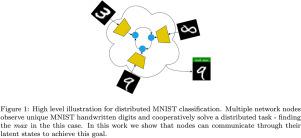Computer Communications ( IF 4.5 ) Pub Date : 2020-07-22 , DOI: 10.1016/j.comcom.2020.07.001 Prince Abudu , Andrew Markham

|
In distributed, cooperative Internet of Things (IoT) settings, sensing devices must communicate in a resource-aware fashion to achieve a diverse set of tasks, (i.e., event detection, image classification). In such settings, we continue to see a shift from reliance on cloud-centric to edge-centric architectures for data processing, inference and actuation. Distributed edge inference techniques address real-time, connectivity, network bandwidth and latency challenges in spatially distributed IoT applications. Achieving efficient, resource-aware communication in such systems is a longstanding challenge. Many current approaches require complex, hand-engineered communication protocols. In this paper, we present a novel scalable, data-driven and communication-efficient Convolutional Recurrent Neural Network (C-RNN) framework for distributed tasks. We provide empirical and systematic analyses of model convergence, node scalability, computation-cost and communication-cost based on dynamic network graphs. Further to this, we show that our framework is able to solve distributed image classification tasks via automatically learned communication.
中文翻译:

学习物联网中的分布式通信和计算
在分布式的协作式物联网(IoT)设置中,传感设备必须以资源感知的方式进行通信,以实现多种任务集(即事件检测,图像分类)。在这种情况下,我们继续看到从对数据的处理,推理和激活的以云为中心的架构向以边缘为中心的架构转变。分布式边缘推理技术可解决空间分布式物联网应用程序中的实时性,连接性,网络带宽和延迟问题。在这样的系统中实现有效的资源感知通信是一项长期的挑战。当前许多方法需要复杂的手工设计的通信协议。在本文中,我们提出了一种新颖的可扩展,数据驱动和通信高效的卷积循环神经网络(C-RNN)框架,用于分布式任务。我们提供基于动态网络图的模型收敛性,节点可伸缩性,计算成本和通信成本的经验和系统分析。除此之外,我们表明我们的框架能够通过自动学习的通信解决分布式图像分类任务。









































 京公网安备 11010802027423号
京公网安备 11010802027423号